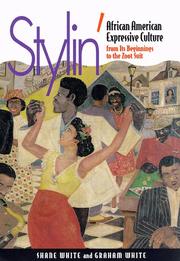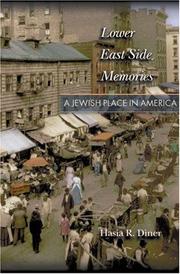| Listing 1 - 2 of 2 |
Sort by
|

ISBN: 0801431794 1501718088 9781501718083 Year: 1999 Publisher: London : Baltimore, Md. : Cornell University Press, Project MUSE,
Abstract | Keywords | Export | Availability | Bookmark
 Loading...
Loading...Choose an application
- Reference Manager
- EndNote
- RefWorks (Direct export to RefWorks)
For over two centuries, in the North as well as the South, both within their own community and in the public arena, African Americans have presented their bodies in culturally distinctive ways. Shane White and Graham White consider the deeper significance of the ways in which African Americans have dressed, walked, danced, arranged their hair, and communicated in silent gestures. They ask what elaborate hair styles, bright colors, bandanas, long watch chains, and zoot suits, for example, have really meant, and discuss style itself as an expression of deep-seated cultural imperatives. Their wide-ranging exploration of black style from its African origins to the 1940s reveals a culture that differed from that of the dominant racial group in ways that were often subtle and elusive. A wealth of black-and-white illustrations show the range of African American experience in America, emanating from all parts of the country, from cities and farms, from slave plantations, and Chicago beauty contests. White and White argue that the politics of black style is, in fact, the politics of metaphor, always ambiguous because it is always indirect. To tease out these ambiguities, they examine extensive sources, including advertisements for runaway slaves, interviews recorded with surviving ex-slaves in the 1930s, autobiographies, travelers' accounts, photographs, paintings, prints, newspapers, and images drawn from popular culture, such as the stereotypes of Jim Crow and Zip Coon.
African Americans --- Social life and customs --- Hairstyles --- United States --- History --- Body image --- Clothing and dress --- Obraz ciała --- Fryzury --- Czarni Amerykanie --- aspekt społeczny --- historia. --- strój --- obyczaje i zwyczaje.

ISBN: 0691007470 Year: 2002 Publisher: Oxford, England : Princeton University Press,
Abstract | Keywords | Export | Availability | Bookmark
 Loading...
Loading...Choose an application
- Reference Manager
- EndNote
- RefWorks (Direct export to RefWorks)
Manhattan's Lower East Side stands for Jewish experience in America. With the possible exception of African-Americans and Harlem, no ethnic group has been so thoroughly understood and imagined through a particular chunk of space. Despite the fact that most American Jews have never set foot there--and many come from families that did not immigrate through New York much less reside on Hester or Delancey Street--the Lower East Side is firm in their collective memory. Whether they have been there or not, people reminisce about the Lower East Side as the place where life pulsated, bread tasted better, relationships were richer, tradition thrived, and passions flared. This was not always so. During the years now fondly recalled (1880-1930), the neighborhood was only occasionally called the Lower East Side. Though largely populated by Jews from Eastern Europe, it was not ethnically or even religiously homogenous. The tenements, grinding poverty, sweatshops, and packs of roaming children were considered the stuff of social work, not nostalgia and romance. To learn when and why this dark warren of pushcart-lined streets became an icon, Hasia Diner follows a wide trail of high and popular culture. She examines children's stories, novels, movies, museum exhibits, television shows, summer-camp reenactments, walking tours, consumer catalogues, and photos hung on deli walls far from Manhattan. Diner finds that it was after World War II when the Lower East Side was enshrined as the place through which Jews passed from European oppression to the promised land of America. The space became sacred at a time when Jews were simultaneously absorbing the enormity of the Holocaust and finding acceptance and opportunity in an increasingly liberal United States. Particularly after 1960, the Lower East Side gave often secularized and suburban Jews a biblical, yet distinctly American story about who they were and how they got here. Displaying the author's own fondness for the Lower East Side of story books, combined with a commitment to historical truth, Lower East Side Memories is an insightful account of one of our most famous neighborhoods and its power to shape identity.
Immigrants --- Jews --- Social life and customs --- Intellectual life --- HISTORY / Jewish. --- Hebrews --- Israelites --- Jewish people --- Jewry --- Judaic people --- Judaists --- Ethnology --- Religious adherents --- Semites --- Judaism --- Emigrants --- Foreign-born population --- Foreign population --- Foreigners --- Migrants --- Persons --- Aliens --- Lower East Side (New York, N.Y.) --- New York (State) --- LES (New York, N.Y.) --- Nyu Yorḳ (State) --- NYS --- Niyū Yūrk (State) --- Nʹi︠u︡-Ĭork (State) --- Shtat Nʹi︠u︡ Ĭork --- State of New York --- State of N. York --- NY (State) --- N.Y. (State) --- N. York (State) --- نيويورك (State) --- ولاية نيويورك --- Wilāyat Niyū Yūrk --- Штат Нью-Ёрк --- Нью-Ёрк (State) --- Ню Йорк (State) --- Nova York (State) --- С̧ӗнӗ Йорк (State) --- Śĕnĕ Ĭork (State) --- Efrog Newydd (State) --- Kin Yótʼááh Deezʼá Hahoodzo --- Nííyóó Hahoodzo --- New Yorgi osariik --- Νέα Υόρκη (State) --- Nea Yorkē (State) --- Πολιτεία της Νέας Υόρκης --- Politeia tēs Neas Yorkēs --- Nueva York (State) --- Estado de Nueva York --- Nov-Jorkio --- Ŝtato de Nov-Jorkio --- État de New York --- Nua-Eabhrac (State) --- York Noa (State) --- Eabhraig Nuadh (State) --- Estado de Nova York --- Néu-Yok (State) --- Шин Йорк (State) --- Shin Ĭork (State) --- 뉴욕 주 --- Nyuyok-ju --- 뉴욕 (State) --- Nyuyok (State) --- Nuioka (State) --- Nú Yọk (State) --- Tchiaq York (State) --- New York Isifunda --- New York-fylki --- ניו יורק (State) --- מדינת ניו יורק --- Medinat Nyu Yorḳ --- Stat Evrek Nowydh --- Evrek Nowydh (State) --- Nou Yòk (State) --- Novum Eboracum (State) --- N̦ujorka (State) --- Niujorko valstija --- Niujorkas (State) --- Niorche (State) --- Њујорк (State) --- Njujork (State) --- Yancuīc York (State) --- ニューヨーク州 --- Nyū Yōku-shū --- ニューヨーク (State) --- Nyū Yōku (State) --- New York (Colony) --- Ethnic relations. --- Adler, Jacob. --- Aleichem, Sholem. --- American Vaudeville Theater. --- Baker, Zachary. --- Bible/Biblical. --- Café Metropole. --- Cahan, Abraham. --- Crossing Delancey. --- Current Literature. --- Diamond, Neil. --- Dissent. --- Eastern Europe. --- Eldridge Street Project. --- Ellis Island. --- Esther-Khaye. --- Forward. --- Franklin, Benjamin. --- Glackens, William. --- Goldreich, Gloria. --- Gropper, William. --- Hapgood, Hutchins. --- Humoresque. --- Industrial Removal Office. --- Jerusalem. --- Kelley, Florence. --- Levine, Lawrence. --- Lincoln, Abraham. --- Margolin, Elias. --- Mayflower. --- Raphaelson, Samuel. --- Rischin, Moses. --- Sanders, Ronald. --- Tenement Museum. --- The Jazz Singer. --- Uncle Moses. --- World War II/Holocaust. --- Yezierska, Anzia. --- Yiddish theater. --- Zagajewski, Adam. --- Zueblin, Charles. --- anti-Semitism. --- booksellers. --- business. --- food. --- garment industry. --- history. --- journalism. --- philanthropy. --- pogroms. --- settlement houses. --- summer camps. --- East Side, Lower (New York, N.Y.) --- Imigranci --- Żydzi --- obyczaje i zwyczaje --- życie intelektualne --- Nowy Jork (Stany Zjednoczone) --- stosunki międzyetniczne.
| Listing 1 - 2 of 2 |
Sort by
|

 Search
Search Feedback
Feedback About UniCat
About UniCat  Help
Help News
News